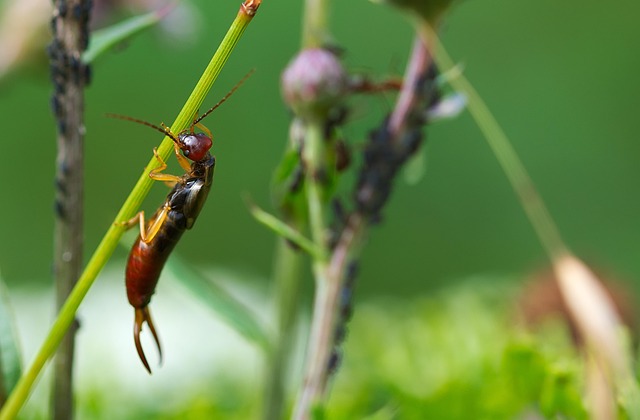Earwig infestations in indoor spaces require a strategic approach that includes regular inspections, tracking with sticky traps, and understanding hiding spots. Safe removal techniques involve using vacuum cleaners or damp paper towels with soap. Natural repellents like peppermint oil can help, but persistent infestations may necessitate professional earwig infestation treatment. Prevention strategies include sealing entry points, maintaining cleanliness, using natural deterrents, and ensuring good ventilation. If DIY efforts fail, consult a pest control professional specializing in earwig infestation treatment for comprehensive, targeted solutions, especially for large-scale or recurring issues.
Discover how to safely bid farewell to earwigs infesting your indoor spaces. This comprehensive guide offers a multi-pronged approach to dealing with these pesky intruders, from identifying and tracking their presence to effective removal techniques. Learn about preventing future infestations and when to seek professional help for robust earwig infestation treatment.
Understanding Earwig Infestation: Identifying and Tracking Pests
Earwig infestations can be a concern for indoor spaces, but understanding how to identify and track these pests is a crucial step in their safe removal. Earwigs are often attracted by moisture and dark, cramped areas, making them common in kitchens, bathrooms, and basements. They leave behind telltale signs of their presence, such as small holes in plants, silk threads (which they use to build nests), and the distinctive smell of their excrement. Regular inspections, particularly in these high-risk areas, can help you spot any early signs of an infestation.
Tracking earwigs involves a combination of visual observation and setting up traps. Check for live insects or shed skins under lights, along baseboards, behind appliances, and inside cabinets. Sticky traps placed near entry points and potential hiding spots can also capture moving earworms, aiding in their identification and allowing you to monitor the extent of the infestation. Once you’ve identified the location and magnitude of the problem, you’re ready to proceed with safe removal techniques for earwig infestation treatment.
Safe Removal Techniques: Steps to Eliminate Earwigs Indoors
To safely remove earwigs from indoor spaces, it’s crucial to understand their behavior and choose effective yet non-toxic methods. Start by identifying the areas where earwigs are most likely to congregate—cracks, crevices, baseboards, and dark corners. Use a flashlight to inspect these areas at night when earwigs are most active. Next, employ gentle yet powerful removal techniques like using a vacuum cleaner equipped with a brush attachment to suck them up. Damp paper towels or cotton balls dipped in soapy water can also trap earwigs effectively.
For more persistent earwig infestations, consider natural repellents like peppermint oil or diatomaceous earth. Peppermint oil, known for its strong scent, can deter earwigs from infested areas. Diatomaceous earth, made from fossilized algae, is safe for indoor use and disrupts the exoskeletons of insects when they come into contact with it. In severe cases, consult a pest control professional who specializes in earwig infestation treatment for more comprehensive and targeted solutions.
Preventing Future Infestations: Tips for Earwig Control
To prevent future earwig infestations, it’s crucial to implement certain control measures around your home or indoor spaces. Start by sealing any potential entry points—cracks, gaps in walls, windows, and doors—with caulk or weatherstripping. Regularly inspect potted plants for signs of earwigs before bringing them indoors, as these insects often hide among plant debris. Maintain a clean environment, especially in kitchens and bathrooms, by promptly cleaning up spills and crumbs, and ensuring food is stored securely in sealed containers. Additionally, keep your home well-ventilated and use natural deterrents like citrus oils or mint around entry points to discourage earwigs from seeking shelter indoors. Regular pest control inspections can also help identify and address any emerging issues early on, making earwig infestation treatment more effective.
Professional Help: When to Seek Expert Assistance for Earwig Treatment
If an earwig infestation persists or worsens despite your best efforts, it may be time to seek professional help. While DIY methods can be effective for small infestations, earwigs can quickly multiply and establish themselves in hard-to-reach areas, making them difficult to eradicate alone. Professional pest control services have the expertise and tools needed to tackle severe earwig problems effectively.
Experts in earwig infestation treatment will use safe and targeted strategies to eliminate adult earwigs, their eggs, and larvae from your indoor spaces. They can also provide preventative measures to deter future infestations. Consulting a professional is especially crucial if you have a large-scale or recurring issue, as they can identify the specific species of earwig causing the problem and tailor their treatment accordingly.
In conclusion, effectively managing an earwig infestation requires a multi-step approach. By understanding these pests’ behavior through identification and tracking, you can employ safe removal techniques tailored to indoor environments. Implementing preventive measures like sealing entry points and maintaining hygiene significantly reduces the risk of future infestations. Should the issue persist or involve extensive damage, seeking professional help ensures a thorough earwig infestation treatment. With the right strategies in place, it’s possible to rid your spaces of these unwelcome visitors and create an environment that feels comfortable and pest-free.
